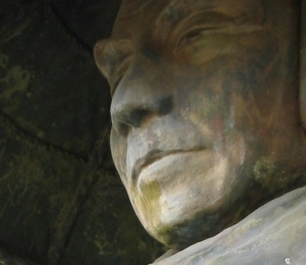Buddhism on Riverside Drive
With a Vital Message from D. T. Suzuki
With a Vital Message from D. T. Suzuki
Photo and complete text: diogenesii.wordpress.com — not available
Unlike most of the buildings in Hiroshima, the bronze figure of Shinran Shonin (1173–1263) — the Japanese Buddhist monk who founded Jodo Shinshu (Shin) Buddhism — miraculously survived the devastation. The 15-foot statue had stood 2.5 kilometers northwest from the hypocenter of the detonation of the atomic bomb. It depicts Shinran Shonin in his missionary travel robe as he appeared most of his life propagating the doctrine he developed to reveal the one unobstructed way through which one can become awakened.
Unlike most of the buildings in Hiroshima, the bronze figure of Shinran Shonin (1173–1263) — the Japanese Buddhist monk who founded Jodo Shinshu (Shin) Buddhism — miraculously survived the devastation. The 15-foot statue had stood 2.5 kilometers northwest from the hypocenter of the detonation of the atomic bomb. It depicts Shinran Shonin in his missionary travel robe as he appeared most of his life propagating the doctrine he developed to reveal the one unobstructed way through which one can become awakened.
In 1955, the statue was removed from the Hiroshima park, packed into an enormous wooden crate, and shipped to New York City, where it was presented to the New York Buddhist Church on Riverside Drive near 106th Street in Manhattan as a testament to the devastation of the atomic bomb as well as a symbol for hope and world peace.
On 11 September 1955, just over ten years after the bombing of Hiroshima, D. T. Suzuki — one of the most influential figures in introducing Zen Buddhism to the West — gave an eloquent keynote address at the statue’s unveiling ceremony. In this address, I think Suzuki best answers the question, “Why?”, that I began with:
On 11 September 1955, just over ten years after the bombing of Hiroshima, D. T. Suzuki — one of the most influential figures in introducing Zen Buddhism to the West — gave an eloquent keynote address at the statue’s unveiling ceremony. In this address, I think Suzuki best answers the question, “Why?”, that I began with:
The present state of things as we are facing everywhere politically, economically, morally, intellectually, and spiritually is no doubt the result of our past thoughts and deeds we have committed as human beings through[out] the whole length of history, through aeons of existence, not only individually but collectively — let me repeat, collectively. As such, we are, every one of us, responsible for the present world situation filled with [its] awesome forebodings. The bombing of Hiroshima was not, after all, the doing of the American armies, but the doing of mankind as a whole, and as such, we, not only the Japanese and Americans but the whole world, are to be held responsible for the wholesale slaughter witnessed ten years ago….As far as I can see, [we must find] the living Shonin who is surely among us answering to the call of his name; only we have not been able to hear his response, our ears have not yet been fully opened innerly as well as outwardly to [that] still small voice….We must realize that modern civilization is thoroughly oriented towards dehumanizing humanity in every possible way; that is to say, we are fast turning into robots or statues with no human souls. Our task is to get humanized once more.
The statue stands a few blocks from Columbia University, where much of the atomic bomb program began.




No comments:
Post a Comment